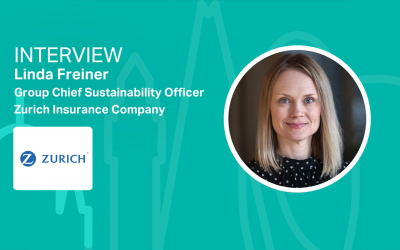Patrick Mispagel on how the pandemic has renewed focus on green financing
Patrick Mispagel from Moody’s talks to Climate Action about how the pandemic has renewed focus on green financing, driven by the integration of climate risk into the regulatory agenda.

Patrick Mispagel from Moody’s talks to Climate Action about how the pandemic has renewed focus on green financing, driven by the integration of climate risk into the regulatory agenda.
How has the COVID-19 pandemic impacted the sustainable investment market?
There is little doubt that sustainable investing has emerged stronger from the height of the coronavirus pandemic. Global issuance of use-of-proceeds green, social and sustainability bonds hit record volumes in 2020 at $491 billion, up from $324 billion a year prior and less than $50 billion only five years ago. Coupled with the growth of new structures – notably sustainability-linked bonds – last year’s volumes were around the $600bn mark, despite pandemic-induced economic and financial volatility in the second quarter.
We expect a growing number of issuers to turn to labelled bonds, both use-of-proceeds and sustainability-linked structures, to communicate their sustainability objectives to the market. Labelled bonds often become an effective and efficient way for a company to start the sustainability dialogue with stakeholders and build an internal reporting infrastructure necessary to respond to their information needs. Such dialogue has become even more important in the post-pandemic era.
Institutional investors will also continue to increase the percentage of assets under management invested sustainably, driving demand for ESG-compliant financial products. We expect 37% of global assets to be invested sustainability by around 2025, from less than 20% in 2020.
As the pandemic has highlighted societal inequalities do you think green finance will continue to dominate throughout 2021 and beyond?
With the pandemic highlighting structural inequities and other societal issues, social financing came of age last year, with the mix of projects funded diversifying significantly beyond the traditional “green” variety that dominated the market in its earlier stages. Indeed, social bond issuance reached $141 billion in 2020, up from just $17 billion in 2019. Supported by recovery plans focussed on employment and social investment, we expect governments and multilaterals to increasingly turn to social bonds as part of their funding mix, underpin healthy volume growth over the coming quarters.
That said, we will see a renewed focus on green financing this year driven by the integration of climate risk into the regulatory and supervisory agenda, the continued development of standards (notably the forthcoming EU Green Bond Standard), and a ramp-up in green stimulus and climate policy ambitions in the lead-up and aftermath of COP26 in Glasgow.
Do you think that the green stimulus plans of central governments and agencies will lead to the issuing of more labelled bonds to raise capital for sustainable and climate aligned activities?
Sovereign green, social and sustainability issuance reached $40.5 billion in 2020, from just $17.5 billion in 2018 and $21.8 billion in 2019. Another strong year in 2021 is on the cards.
Governments and agencies will increasingly issue labelled bonds to raise capital for sustainable development and climate-aligned activities, in part driven by green stimulus plans to reignite post-pandemic economic growth.
For example, earlier this year, Moody’s affiliate V.E. provided the Second Party Opinion on Italy’s sovereign green bond framework and maiden green bond issuance. The landmark €8.5 billion transaction will be used to finance budget lines reflective of Italy’s environmental priorities, including renewable energy and clean transportation.
Sovereign issuers are at the forefront of responding to social and environmental risks presented by climate change, as well as other key challenges, such as ensuring social cohesiveness in the face of growing income inequality. These efforts are often interlinked as lower-income and disadvantaged groups tend to be more exposed and susceptible to the damage caused by climate change, such as loss of agricultural employment and income.
Does the increasing diversification of products create greater flexibility for issuers and investment options for investors?
The big story from last year was the rise to prominence of sustainability-linked bonds. These are a complementary financing instrument to traditional green, social and sustainable bonds that provide flexibility on the use of proceeds. They offer a more dynamic vision of sustainability, requiring issuers to define and commit to a sustainability path over a period of years through the selection of one or several KPIs or an ESG assessment
Importantly, we now have standards for sustainability-linked bonds, which will quickly lead to the establishment of best practice. In June 2020, the ICMA released the Sustainability-Linked Bond Principles (SLBPs) to guide market participants in structuring this new type of sustainable finance instrument.
Sustainability-linked bonds are open to issuers across all sectors, and therefore are expected to play a key role for companies looking to transition their business models towards more sustainable pathways. V.E has already delivered SPOs on sustainability-linked bond frameworks from a diverse array of companies, including Chanel, Enel, Etihad Airways, Schneider Electric and NRG, to name a few. For investors, an increasingly diverse range of sectors and issuers will help mitigate diversification risk in the use-of-proceeds market.
Whether a use-of-proceeds or sustainability-linked structure, it’s important that targets and reporting are credible, and that the transaction is linked to the company’s broader sustainability objectives.
Moody's is an Industry Partner of the Sustainable Investment Forum Europe in April, bringing together asset owners and managers, ratings agencies, banks, UN and Government policymakers, investors, development banks, think tanks, and NGOs committed to driving forward the sustainable finance agenda. Register your place for free here.





